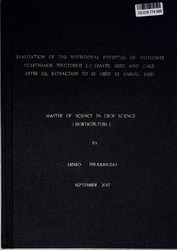| dc.description.abstract | Safflower is an annual oil seed crop adapted to arid and saline regions of the world, is a
potentially novel food and medicine source, which has not been fully explored in the last
century. Safflower’s ability to forage for sub-soil moisture with its vigorous tap root,
tolerance to salinity, adaptability to wide range of temperatures, improved oil content and its
versatility to produce oil high in linoleic and oleic fatty acids makes it a viable alternative to
current crops grown in the more marginal cropping areas around the world. This study was
carried out to evaluate the nutritional potential of the safflower leaves, seed and cake after oil
extraction to be used as animal feed. Nine safflower genotypes were evaluated in a
completely randomized block design with three replications in the Botswana University of
Agriculture and Natural Resources, Notwane Farm under sandy loam soils. Tire results of the
study showed that safflower genotypes significantly (P < 0.05) differed in oil, crude protein
(CP), dry matter (DM), neutral detergent fiber (NDF), acid detergent fiber (ADF), acid
detergent lignin (ADL), ash and mineral contents of the leaves, whole seeds and cake after oil
extraction. The cake CP, NDF, ADF, ADL and ash contents significantly (P < 0.05) varied
between 19.3-22.5, 54.6-61.2, 45.0-50.7, 18.0-20.8, and 1.10-1.60%, respectively,
depending on genotype and growing season. While the seed mineral content significantly (P
< 0.05) varied between 6.98-7.90 mg/g P, 10.68-12.91 mg/g K, 8.78-10.61 mg/g Ca, 4.45-
4.99 mg/g Mg, 90-120 ppm Zn, 70-90 pg/g Fe, 40-50 pg/g Mn, and 90-130 pg/g Cu,
respectively, depending on genotype and growing season. Significant (P < 0.05) differences
were also observed in the seed oil content, DM, CP, NDF, ADF, ADL and ash which varied
between 26.13-42.17, 91.9-96.1, 16.3-19.1, 42.6-50.3, 39.7-48, 13.5-20.7, and 0.95-
1.41%, respectively, depending on genotype and growing season. The seed mineral content
significantly (P < 0.05) differed between 5.47-7.87 mg/g P, 8.44-12.26 mg/g K, 11.33-9.45
mg/g Ca, 4.37-5.55 mg/g Mg, 3.24-3.57 mg/g Na, 90-120 pg/g Zn, 50-80 pg/g Fc, 30-50 pg/g Mn, and 130-170 pg/g Cu, respectively, depending on genotype and growing season.
Tlte leaf DM, CP, ND, ADF, ADL and ash significantly (P < 0.05) varied between 88.1-91.2,
21.1-27.7, 20.5-26.2, 26.5-32.7, 6.7-10.7, and 0.89-1.13%, respectively, depending on
genotype and growing season. The leaf mineral content significantly (P < 0.05) differed
between 3.31-4.95 mg/g P, 56.13-66.54 mg/g K, 10.61-16.51 mg/g Ca, 3.91-4.92 mg/g Mg,
0.51-0.69 mg/g Na, 70-90 pg/g Zn, 310-460 pg/g Fe, 280-380 pg/g Mn, and 6.3-8.3 pg/g
Cu, respectively, depending on genotype and growing season. In conclusion, safflower has a
great potential to be grown in Botswana as an oilseed crop and source of animal feed. | en_US |

